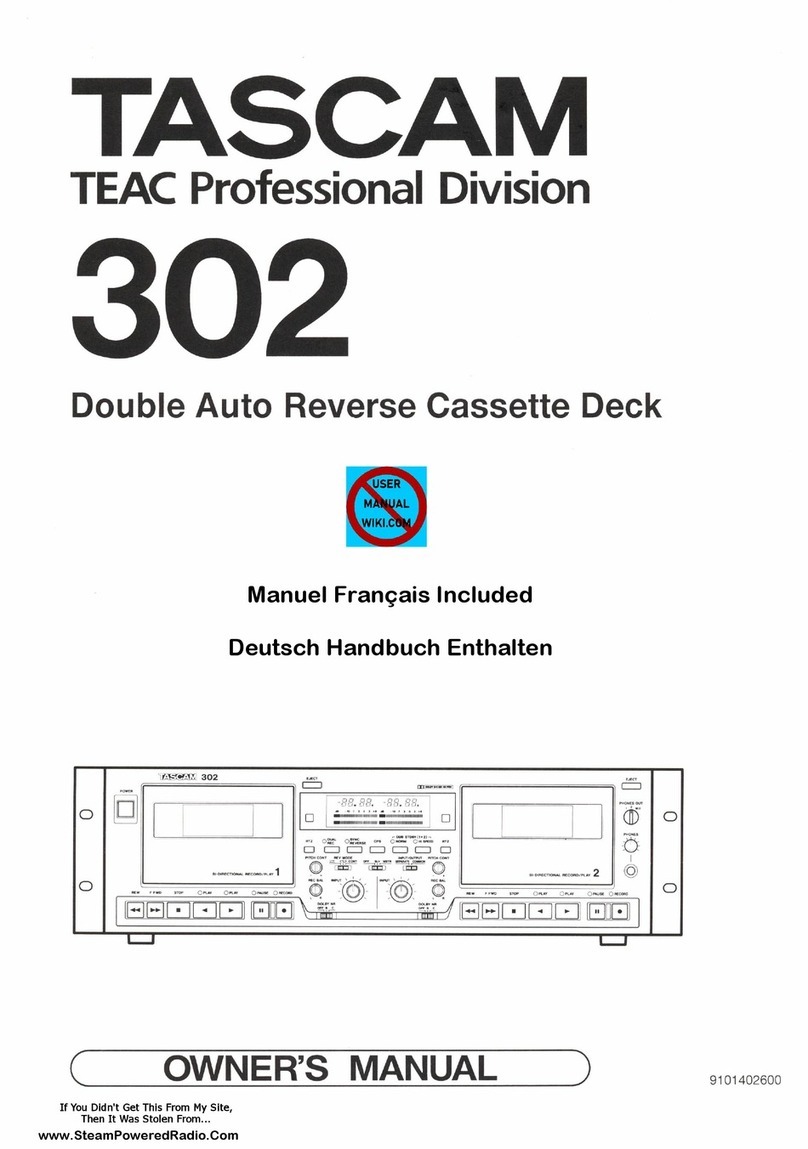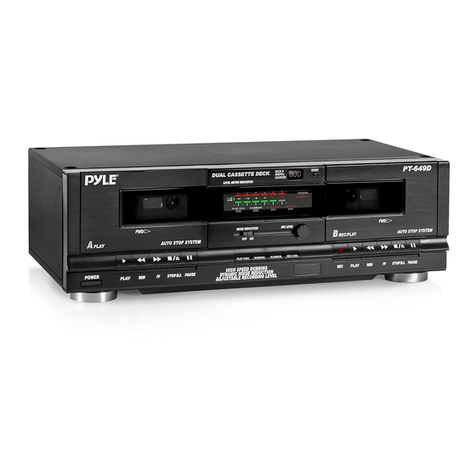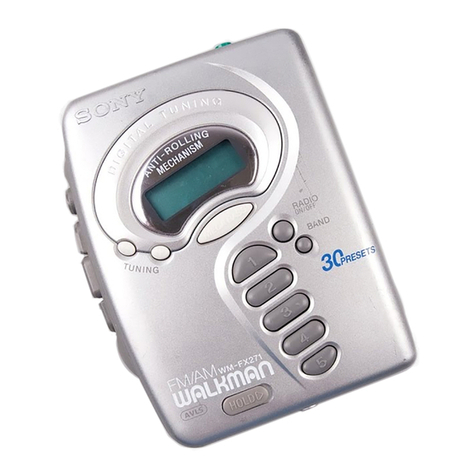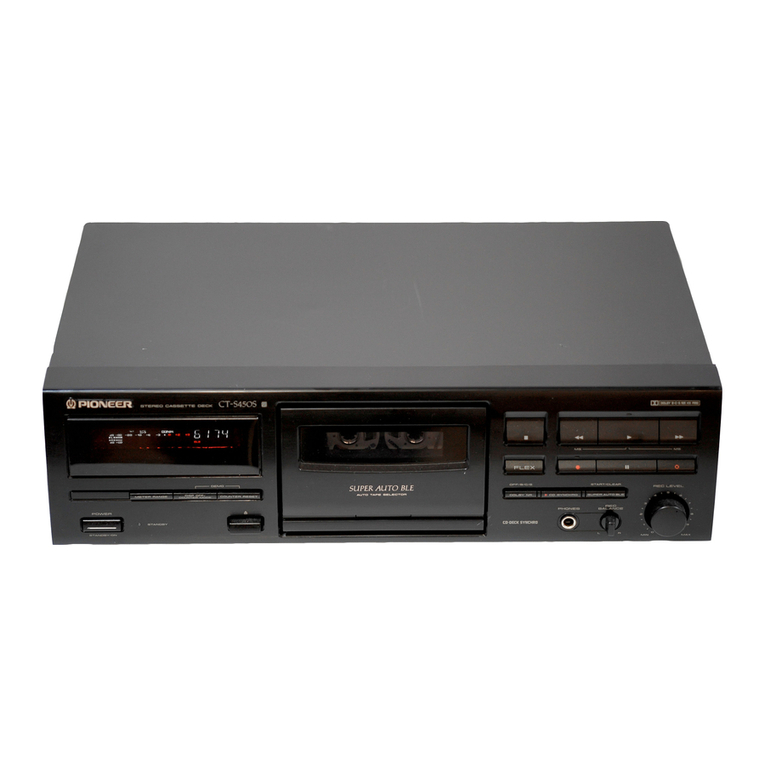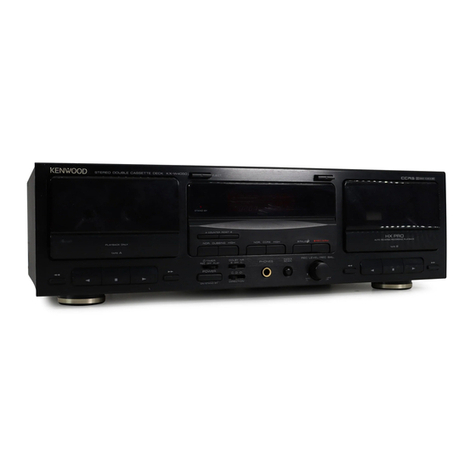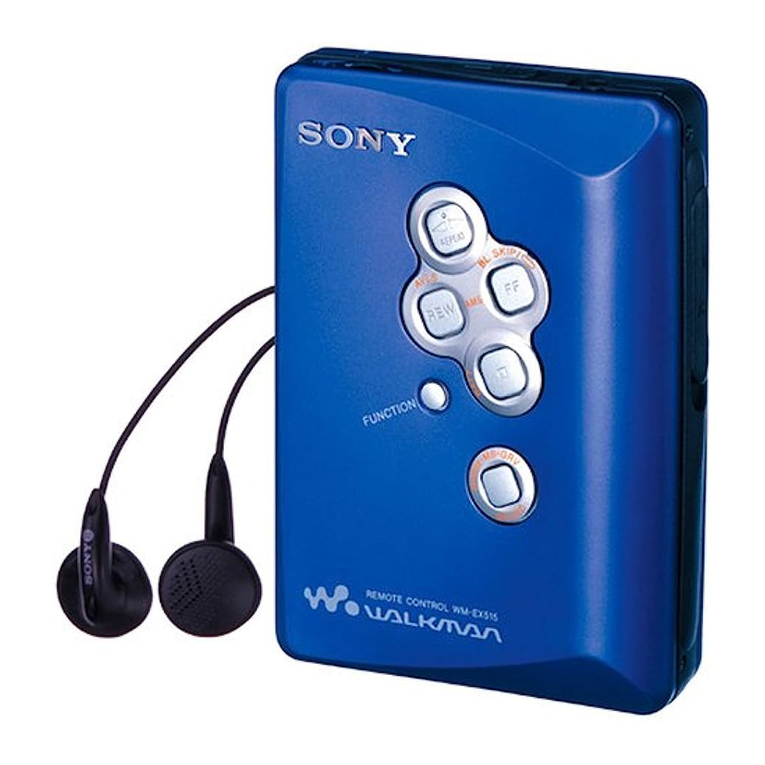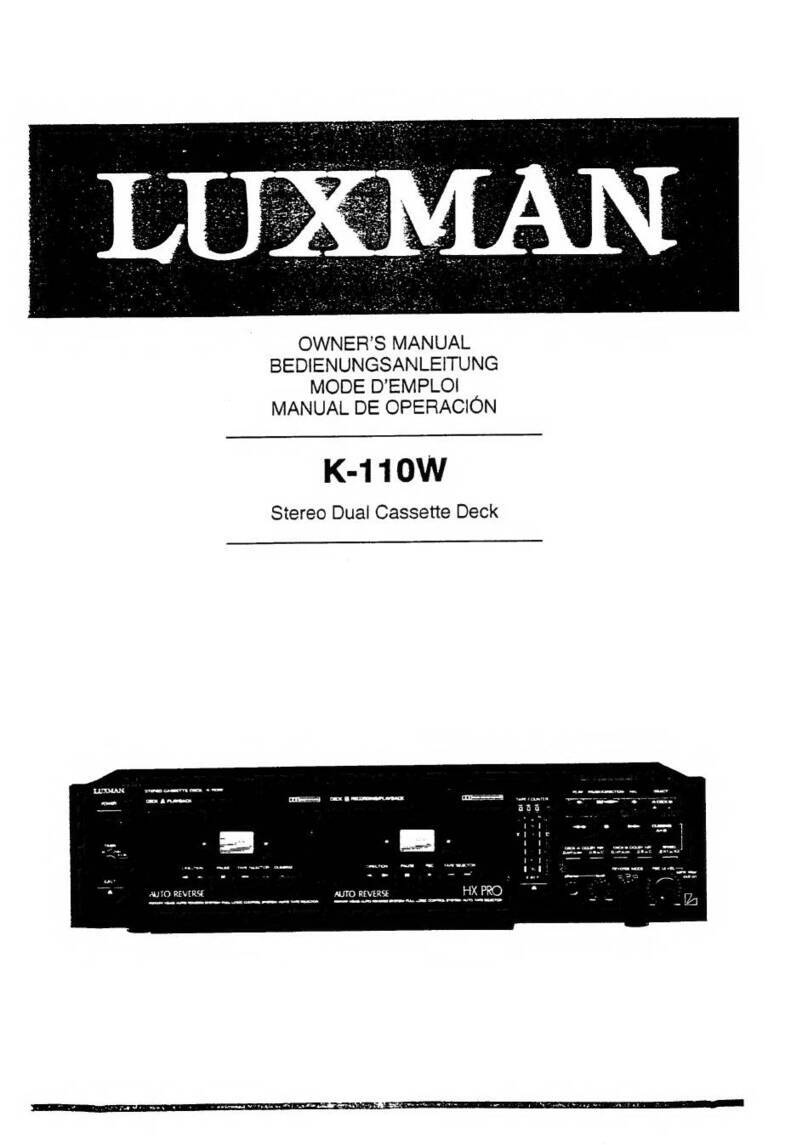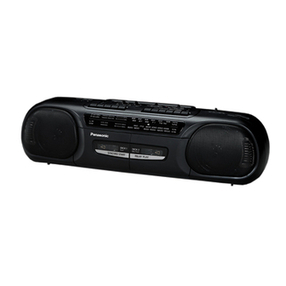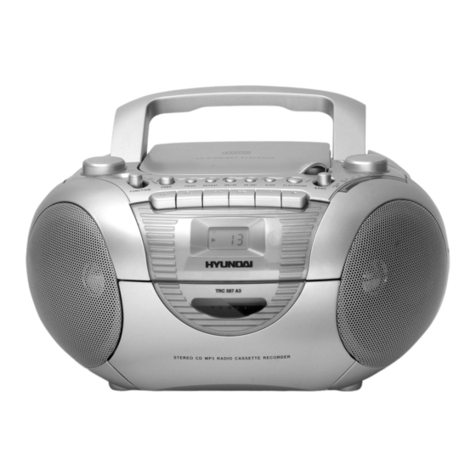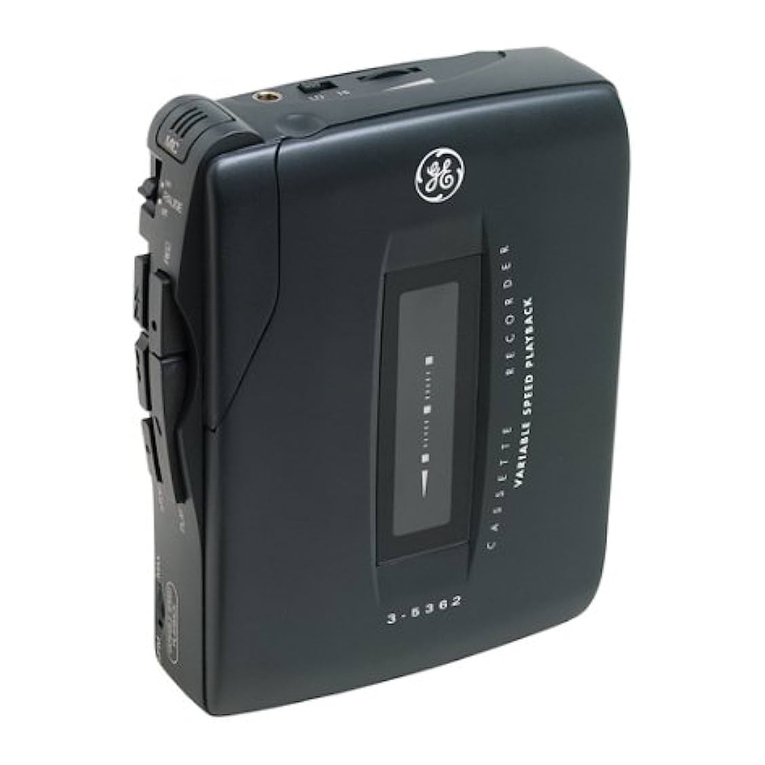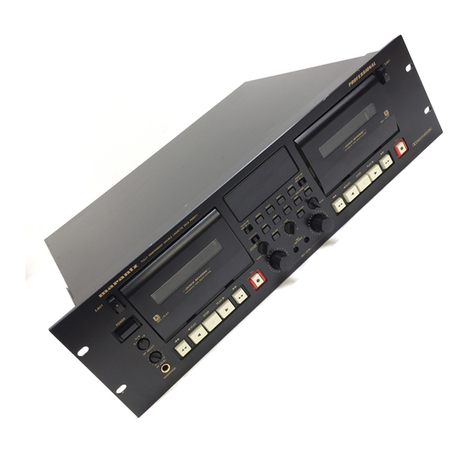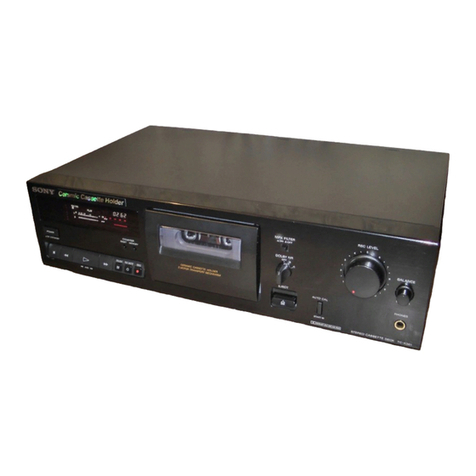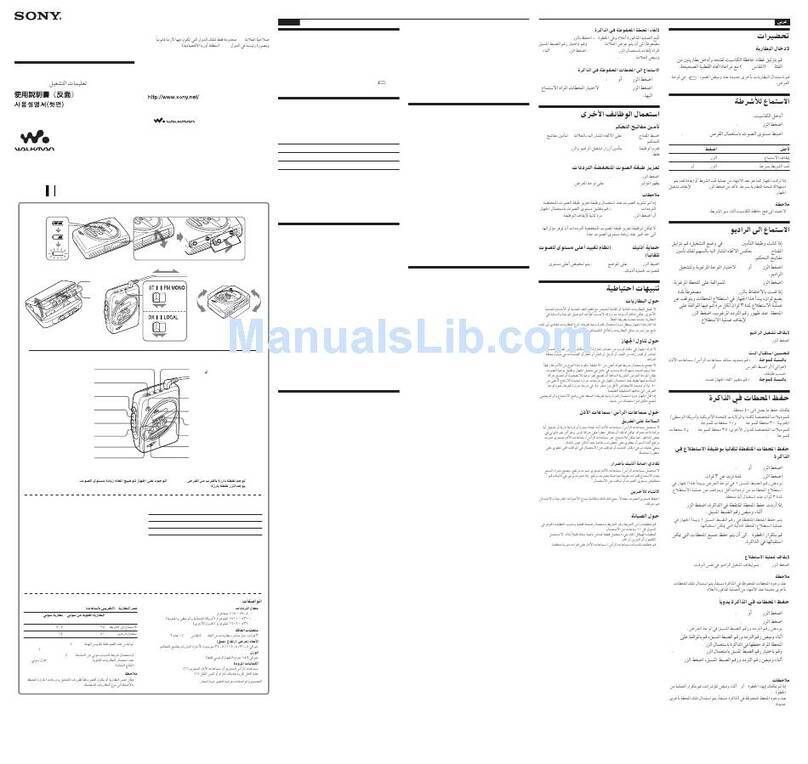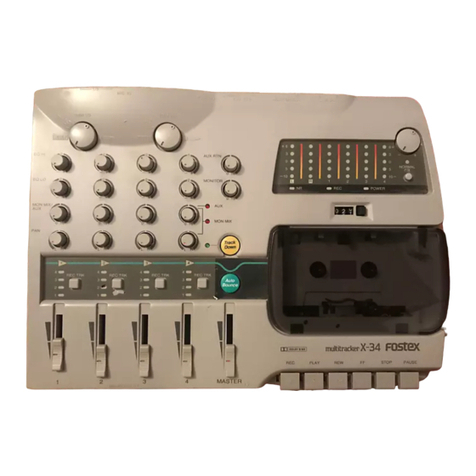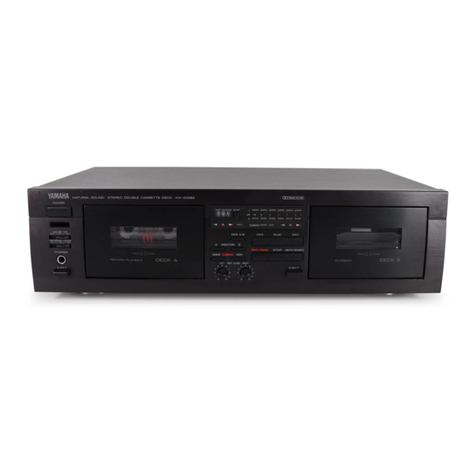TEAC PROFESSIONAL Tascam 102mkII User manual

TASCAM
7
TEAC
Professional
Division
102Mkil
Master
Cassette
Deck
TASCAM
102
мк
SYNG
WLARMA
BCAM
Ie
С]
пап
2;
®
TEX
fr
ai
nr
Глу]
PAUSE
n
ie
Fri:
v»
Е]
@
СП
OWNER'S
MANUAL
Айа
A
The
lightning
flash
with
arrowhead
symbol,
within
an
equilateral
triangle,
is
intended
to
alert
the
user
A
to
the
presence
of
uninsulated
“dangerous
voltage"
within
the
product's
enclosure
that
may
be
of
sufficient
magnitude
to
constitute
a
risk
of
electric
shock
to
persons.
-
CAUTION:
TO
REDUCE
THE
RISK
OF
ELECTRIC
SHOCK,
DO
NOT
REMOVE
COVER
(OR
BACK).
NO
USER-SERVICEABLE
PARTS
INSIDE.
REFER
SERVICING
.
TO
QUALIFIED
SERVICE
PERSONNEL.
The
exclamation
point
within
an
equilateral
triangle
is
intended
to
alert
the
user
to
the
presence
of
A
important
operating
and
maintenance
(Servicing)
instructions
in
the
literature
accompanying
the
appliance.
|
This
appliance
has
a
serial
number
located
on
the
rear
panel.
Please
record
the
model
number
and
serial
number
and
retain
them
for
WARNING:
TO
PREVENT
FIRE
OR
SHOCK
HAZARD,
DO
NOT
EXPOSE
THIS
APPLIANCE
TO
RAIN
OR
MOISTURE.
your
records.
Model
number
Serial
number

Important
Safety
Instructions
CAUTION:
e
Read
all
of
these
Instructions.
e
Save
these
Instructions
for
later
use.
e
Follow
all
Warnings
and
Instructions
marked
on
the
audio
equipment.
1)
Read
instructions
—
All
the
safety
and
operating
instructions
should
be
read
before
the
product
is
operated.
2)
Retain
instructions
—
The
safety
and
operating
instructions
should
be
retained
for
future
reference.
3)
Heed
Warnings
—
All
warnings
on
the
product
and
in
the
_
operating
instructions
should
be
adhered
to.
4)
Follow
instructions
—
All
operating
and
use
instructions
shoud
‘
be
followed.
5)
Cleaning
—
Unplug
this
product
from
the
wall
outlet
before
cleaning.
Do
not
use
liquid
cleaners
or
aerosol
cleaners.
Use
a
damp
cloth
for
cleaning.
6)
Attachments
—
Do
not
use
attachments
not
gelo
ded
by
the
product
manufacturer
as
they
may
cause
hazards.
7)
Water
and
Moisture
—
Do
not
use
this
product
near
water
—
for
example,
near
a
bath
tub,
wash
bowl,
kitchen
sink,
or
laundry
tub;
in
a
wet
basement;
or
near
a
swimming
pool;
and
the
like.
8)
Accessories
—
Do
not
place
this
product
on
an
unstable
cart,
stand,
tripod,
bracket,
or
table.
The
product
may
fall,
causing
serious
injury
to
a
child
or
adult,
and
serious
damage
to
the
product.
Use
only
with
a
cart,
stand,
tripod,
bracket,
or
table
recommended
by
the
manufacturer,
or
sold
with
the
product.
Any
mounting
of
the
product
should
follow
the
manufacturer's
instructions,
and
should
use
a
mounting
accessory
recommended
by
the
manufacturer.
9)
A
product
and
cart
combination
should
be
moved
with
care.
Quick
stops,
excessive
force,
and
uneven
surfaces
may
cause
the
product
and
cart
combination
to
overturn.
v
-—DRe—
10)
Ventilation
—
Slots
and
openings
in
the
cabinet
are
provided
for
ventilation
and
to
ensure
reliable
operation
of
the
product
and
to
protect
it
from
overheating,
and
these
openings
must
not
be
blocked
or
covered.
The
openings
should
never
be
blocked
by
placing
the
product
on
a
bed,
sofa,
rug,
or
other
similar
surface.
This
product
should
not
be
placed
in
a
built-in
installation
such
as
a
bookcase
or
rack
unless
proper
ventilation
is
provided
or
the
manufacturer's
instructions
have
been
adhered
to.
11)
Power
Sources
—
This
product
should
be
operated
only
from
the
type
of
power
source
indicated
on
the
marking
label.
If
you
are
not
sure
of
the
type
of
power
supply
to
your
home,
consult
your
product
dealer
or
local
power
company.
For
products
intended
to
operate
from
battery
power,
or
other
sources,
refer
to
the
operating
instructions.
12)
Grounding
or
Polarization
—
This
procuct
may
be
equipped
with
a
polarized
alternating-current
line
plug
(a
plug
having
one
blade
wider
than
the
other).
This
plug
will
fit
into
the
power
outlet
only
one
way.
This
is
a
safety
feature.
If
you
are
unable
to
insert
the
plug
fully
into
the
outlet,
try
reversing
the
plug.
If
the
plug
should
still
fail
to
fit,
contact
your
electrician
to
replace
your
obsolete
outlet.
Do
not
defeat
the
safety
purpose
of
the
polarized
plug.
13)
Power-Cord
Protection
—
Power-supply
cords
shoud
be
routed
so
that
they
are
not
likely
to
be
walked
on
or
pinched
by
items
placed
upon
or
against
them,
paying
particular
attention
to
cords
at
plugs,
convenience
receptacles,
and
the
point
where
they
exit
from
the
product.
14)
Outdoor
Antenna
Grounding
—
If
an
outside
antenna
or
cable
system
is
connected
to
the
product,
be
sure
the
antenna
or
cable
system
is
grounded
so
as
to
provide
some
protection
against
voltage
surges
and
built-up
static
charges.
Article
810
of
the
National
Electrical
Code,
ANSI/NFPA
70,
provides
information
with
regard
to
proper
grounding
of
the
mast
and
supporting
structure,
grounding
of
the
lead-in
wire
to
an
antenna
discharge
unit,
size
of
grounding
conductors,
location
of
antenna-discharge
unit,
connection
to
grounding
electrodes,
and
requirements
for the
grounding
electrode.
"Note
to
CATV
system
installer:
This
reminder
is
provided
to
call
the
CATV
system
installer’s
attention
to
Section
820-40
of the
NEC
which
provides
guidelines
for
proper
grounding
and,
in
particular,
specifies
that
the
cable
ground
shall
be
connected
to
the
grounding
system
of
the
building,
as
close
to
the
point
of
cable
entry
as
practical.
Example
of
Antenna
Grounding
as
per
National
Electrical
Code,
ANSUNFPA
70
ELECTRIC
SERVICE
EQUIPMENT
GROUNDING
CONDUCTORS
(NEC
SECTION
810-21)
GROUND
CLAMPS
POWER
SERVICE
GROUNDING
z-——
ELECTRODE
SYSTEM
(NEC
ART
250.
PART
H)
NEC
-
NATIONAL
ELECTRICAL
CODE
15)
Lightning
—
For
added
protection
for
this
product
during
a
lightning
storm,
or
when
it
is
left
unattended
and
unused
for
long
periods
of
time,
unplug
it
from
the
wall
outlet
and
disconnect
the
antenna
or
cable
system.
This
will
prevent
damage
to
the
product
due
to
lightning
and
power-line
surges.
16)
Power
Lines
—
An
outside
antenna
system
should
not
be
located
in
the
vicinity
of
overhead
power
lines
or
other
electric
light
or
power
circuits,
or
where
it
can
fall
into
such
power
lines
or
circuits.
When
installing
an
outside
antenna
system,
extreme
care
should
be
taken
to
keep
from
touching
such
power
lines
or
circuits
as
contact
with
them
might
be
fatal.
17)
Overloading
—
Do
not
overload
wall
outlets,
extension
cords,
Or
integral
convenience
receptacles
as
this
can
result
in
risk
of
fire
or
electric
shock.
18)
Object
and
Liquid
Entry
—
Never
push
objects
of
any
kind
into
this
product
through
openings
as
they
may
touch
dangerous
voltage
points
or
short-out
parts
that
could
result
in
a
fire
or
electric
shock.
Never
spill
liquid
of
any
kind
on
the
product.
19)
Servicing
—
Do
not
attempt
to
service
this
product
yourself
as
opening
or
removing
covers
may
expose
you
to
dangerous
voltage
or
other
hazards.
Refer
all
servicing
to
qualified
service
personnel.
20)
Damage
Requiring
Service
—
Unplug
this
product
from
the
wall
outlet
and
refer
servicing
to
qualified
service
personnel
under
the
following
conditions:
a)
when
the
power-supply
cord
or
plug
is
damaged.
b)
if
liquid
has
been
spilled,
or
objects
have
fallen
into
the
product.
C)
if
the
product
has
been
exposed
to
rain
or
water.
d)
if
the
product
does
not
operate
normally
by
following
the
operating
instructions.
Adjust
only
those
controls
that
are
covered
by
the
operating
instructions
as
an
improper
adjustment
of
other
controls
may
result
in
damage
and
will
often
require
extensive
work
by
a
qualified
technician
to
restore
the
product
to
its
normal
operation.
e)
if
the
product
has
been
dropped
or
damaged
in
any
way.
f)
when
the
product
exhibits
a
distinct
change
in
performance
—
this
indicates
a
need
for
service.
21)
Replacement
Parts
—
When
replacement
parts
are
required,
be
sure
the
service
technician
has
used
replacement
parts
specified
by
the
manufacturer
or
have
the
same
characteristics
as
the
original
part.
Unauthorized
substitutions
may
result
in
fire,
electric
shock,
or
other
hazards.
22)
Safety
Check
—
Upon
completion
of
any
service
or
repairs
to
this
product,
ask
the
service
technician
to
perform
safety
checks
to
determine
that
the
product
is
in
proper
operating
condition.
23)
Wall
or
Ceiling
Mouting
—
The
product
shoud
be
mounted
to
a
wall
or
ceiling
only
as
recommended
by
the
manufacturer.
24)
Heat
—
The
product
should
be
situated
away
from
heat
sources
such
as
radiators,
heat
registers,
stoves,
or
other
products
(including
amplifiers)
that
produce
heat.

REFERENCE
ILLUSTRATIONS
Front
Panel
Display
IN
NORTH
AMERICA
USE
ONLY
ON
120
V
SUPPLY.
DANS
L'AMERIQUE
DU
NORD:
UTILISABLE
SUR
120
V
D'ALIMENTATION
UNIQUEMENT.
CONNECTIONS
(Fig.
1)
@
Turn
off
power
for
all
equipment
before
making
connections.
e
Read
instructions
of
each
component
you
intend
to
use
with
the
deck.
OUTPUT
terminals
OUTPUT
Terminals
on
the
tape
deck
should
be
connected
to
the
TAPE
PLAY
or
LINE
IN
jacks
on
the
amplifier/receiver.
LINE
IN
terminals
LINE
IN
Terminals
on
the
tape
deck
should
be
connected
to
the
REC
OUT
jacks
on
the
amplifier/receiver.
Power
cord
Be
sure
to
connect
the
power
cord
to
an
AC
outlet
which
supplies
the
correct
voltage,
as
set
by
the
voltage
selector.

Stereo
Amplifier
Rear
Panel
102MKII
VOLTAGE
BELECTOR
230v
120%
VOLTAGE
SELECTOR
230V
120V
p
То
AC
outlet
Fig.
5
Connection
for
CD
synchro
dubbing
Normal
Tapes
Chrome
(Cobalt)
Tapes
Metal
Tapes
ө
Tape
position
identification
holes.
Capstan
Record/Playback
Head
Pinch
Roller
J
Erase
Head
Synchro
cable
WR-7000
(optional)
102MKII
Stereo
amplifier
CD
player

PRECAUTIONS
Environment
Avoid
using
the
deck
in
the
following
conditions:
ө
At
high
temperatures
(near
a
heater,
exposed
to
direct
sunlight,
etc.).
e
At
extremely
low
temperatures.
@
Where
there
is
excessive
humidity.
©
In
a
dusty
atmosphere.
@
Where
power
line
voltage
fluctuations
are
severe
(in
which
case
the
use
of
a
voltage
regulator
may
be
advisable).
Cassette
Tape
(Fig.
2)
Tape
Selection:
For
the
automatic
tape
select
function
to
work
properly,
metal
and
chrome
(cobalt)
tapes
must
have
identification
holes.
Tape
Handling:
Do
not
store
tapes
in
the
following
places:
e
Оп
top
of
heaters,
exposed
to
direct
sunlight
or
in
any
other
places
with
high
temperatures.
€
Near
speakers,
on
TV
sets
or
amplifiers
or
where
they
would
be
exposed
to
strong
magnetic
fields.
e
Where
humidity
is
high
and
in
dirty,
dusty
places.
©
Avoid
dropping
or
subjecting
cassettes
to
excessive
shocks.
ө
As
C-120
tapes
are
physically
weak
and
could
become
entangled
in
the
transport
mechanism,
do
not
use
them.
Voltage
Conversion
(General
export
models
only)
(Fig.
3)
Be
sure
to
remove
the
power
cord
from
the
AC
outlet
before
repositioning
the
voltage
converter
switch.
1.
Locate
the
voltage
selector
on
the
rear
panel.
2.
Using
a
flat-bladed
screwdriver,
set
to
the
appropriate
230
V
or
120
V
position
according
to
your
area.
THE
APPLIANCE
CONFORMS
WITH
EEC
DIRECTIVE
87/308/EEC
REGARD-
ING
INTERFERENCE
SUPPRESSION.
*
Dolby
noise
reduction
and
HX
Pro
headroom
extension
manufactured
under
license
from
Dolby
Laboratories
Licensing
Corporation.
HX
Pro
originated
by
Bang
&
Olufsen.
"DOLBY',
the
double-D
symbol
ПП
and
"HX
PRO"
are
trademarks
of
Dolby
Laboratories
Licensing
Corporation.
FEATURES
AND
CONTROLS
(See
page
3.)
Ө
POWER
Switch
Note:
If
you
switch
the
power
off,
be
sure
to
wait
for
more
than
3
seconds
before
switching
it
on
again.
Ө
CD
SYNC
Button
Ө
Display
Window
Peak
Level
Meter
Transport
Mode
Indicators
CD
SYNC
Indicator
REC/PLAY
Mode
Indicators
Multi
Counter
Pause
Indicator
«ТОСОО
Ө
Tape
Operation
Buttons
STOP
Button
W-:
Play
Button
PAUSE
Button
RECORD
Button
«4
/
te
:
Rewind/CPS
Button
pp
/
>ы
:
Fast
Forward/CPS
Button
Q
COUNTER
RESET
Button
Pressing
the
COUNTER
RESET
Button
resets
the
multi-counter
to
"0000".
Q
Cassette
Holder
@
EJECT
Button
Q
DOLBY
NR
Select
Switch
OFF:
Set
to
this
position
when
you
do
not
want
to
use
any
noise
reduction
system.
ПП
B:
Set
їо
this
position
when
making
a
recording
using
the
Dolby
B
noise
reduction
system,
or
playing
back
tapes
recorded
with
Dolby
B
NR.
|
ПП
C:
Set
to
this
position
when
making
a
recording
using
the
Dolby
C
noise
reduction
system,
ог
playing
back
tapes
recorded
with
Dolby
C
NR.
©
INPUT
Control
Ф)
REC
(Record)
MUTE
Button
Ф
INTRO
CHECK
Button
Ф
BALANCE
Control
(B
PHONES
Jack
Plug
stereo
headphones
into
this
jack
for
private
listening
or
monitoring.
IMPORTANT
(for
U.K.
Customers)
DO
NOT
cut
off
the
mains
plug
from
this
equipment.
If
the
plug
fitted
is
not
suitable
for
the
power
points
in
your
home
or
the
cable
is
too
short
to
reach
a
power
point,
then
obtain
an
appropriate
safety
approved
extension
lead
or
consult
your
dealer.
If
nonetheless
the
mains
plug
is
cut
off,
remove
the
fuse
and
dispose
of
the
plug
immediately,
to
avoid
a
possible
shock
hazard.
by
inadvertent
connection
to
the
mains
supply.
If
this
product
is
not
provided
with
a
mains
plug,
or
one-has
to
be
fitted,
then
follow
the
instructions
given
below:
IMPORTANT.
DO
NOT
make
any
connection
to
the
larger
terminal
which
is
marked
with
the
letter
E
or
by
the
safety
earth
symbol
—
ог
coloured
GREEN
or
GREEN-and-YELLOW.
The
wires
in
the
mains
lead
on
this
product
are
coloured
in
accordance
with
the
following
code:
BLUE:
NEUTRAL
BROWN:
LIVE
As
these
colours
may
not
correspond
with
the
coloured
markings
identifying
the
terminals
in
your
plug
proceed
as
follows:
The
wire
which
is
coloured
BLUE
must
be
connected
to
the
terminal
which
is
marked
with
the
letter
N
or
coloured
BLACK.
The
wire
which
is
coloured
BROWN
must
be
connected
to
the
terminal
which
is
marked
with
the
letter
L
or
coloured
RED.
When
replacing
the
fuse
only
a
correctly
rated
approved
type
should
be
used
and
be
sure
to
re-fit
the
fuse
cover.
IF
IN
DOUBT
—
CONSULT
A
COMPETENT
ELECTRICIAN.

OPERATIONS
Loading
a
Cassette
Tape
1.
Use
your
finger
or
a
pencil
to
turn
the
cassette's
hub
and
take
up
any
slack
tape.
Note:
Avoid
touching
the
tape.
Fingerprints
attract
dust
and
dirt.
Press
the
eject
button
(
&)*
to
open
the
cassette
compartment
door.
Load
the
cassette
tape
with
its
open
edge
facing
down.
Gently
close
the
compartment
door.
|
*
Notes:
e
he
cassette
holder
cannot
be
opened
during
recording
ог
playback.
e
If
the
power
has
been
switched
off
during
play
or
recording,
ejecting
the
cassette
may
be
impossible.
In
such
a
case,
switch
the
power
on
and
press
the
eject
button
again.
1.
Press
the
POWER
switch
to
ON.
2.
Load
a
pre-recorded
cassette.
3.
Setthe
DOLBY
NR
switch
as
required.
4.
Press
the
»
button
to
start
playback.
5.
Adjust
the
volume
with the
amplifier's
volume
control.
e
To
stop
playback,
press
the
STOP
button.
Transport
Mode
Indicators
Deck
Operation
Playback/Record
This
function
makes
searching
for
a
specific
tune
much
easier
by
detecting
the
beginning
of
each
tune
in
sequence.
1.
Press
the
INTRO
CHECK
button.
24.
The
deck
will
fast-wind
to
the
beginning
of
a
tune,
play
the
first
15
ГШ
ПИТ
Г
ТЇ
Fast-forward
CPS
allows
the
selection
and
playback
of
any
tune
up
to
20
tunes
ahead
or
before
the
one
being
played.
This
function
Operates
by
detecting
blank
spaces
of
at
least
4
seconds
between
tunes.
These
blanks
can
be
created
using
the
REC
MUTE
Function.
1.
During
playback,
press
the
[<
or
P»
button
repeatedly
until
the
number
of
tunes
to
be
skipped
appears
in
the
counter
display.
Use
the
MM»
button
for
searching
a
tune
following
the
current
tune
and
«t-a
button
for
a
tune
before
the
current
tune.
Refer
to
the
chart
"How
to
Select
any
Required
Tune
Using
CPS".
ө
if,
by
using
the
=i
the
required
CPS
number
setting
is
exceeded,
use
the
|<
button
to
count
down
the
CPS
number
until
the
required
CPS
number
is
displayed.
How
to
Select
any
Required
Tune
Using
CPS
seconds
(approx.),
then
fast-wind
to
the
beginning
of
the
next
tune,
from
which
point
the
cycle
starts
again.
3.
To
release
the
intro
check
function,
press
the
STOP
button.
e
When
the
»
(Play)
button
is
pressed
during
the
intro
check
mode,
normal
playback
resumes.
More
than
approx.
Blank
4
sec.
required
Direction
of
tape
travel
Approx.
15
sec.
INTRO
CHECK
facility
Fast-forward
e
When
the
i
button
is
pressed,
the
next
tune
is
counted
as
"1"
and
when
the
-a
button
is
pressed,
the
current
tune
is
counted
as
"1"
2.
The
tape
is
fast-wound
to
detect
blanks
between
tunes
until
the
required
tune
is
reached.
Then
playback
starts
from
the
beginning
of
the
designated
tune.
Notes
on
CPS
CPS
operates
by
detecting
and
counting
blanks
of
about
4
seconds,
the
standard
interval
between
tunes.
Therefore,
with
the
following
types
of
tapes,
search
functions
may
not
work
correctly.
e
When
the
intervals
between
tunes
cannot
be
detected.
—
Intervals
of
less
than
4
seconds.
—
High
levels
of
noise
in
intervals.
—
Long
low
level
sections
(in
classical
music,
etc.)
This
problem
can
be
corrected
using
the
REC
MUTE
function.
Ex:
See
(1).
To
select
the
3rd
tune
past
the
current
tape
position,
select
"СРОЗ".
(1)
Current
tape
position
(2)
cm
om
cpl
cs
cm
cm
Following
|
Before
In
example
(1).
if
"t"
is
less
than
|
4
seconds.
it
will
not
be
counted
as
a
blank.
Designate
"CP02"
instead
of
"CPO3"
to
select
the
3rd
tune
in
this
case.
Current
tape
position
Direction
of
tape
travel
(4)
«айы»
Direction
of
tape
travel

Recording
from
a
stereo
system:
Press
the
POWER
switch
to
ON.
Load
a
recordable
cassette.
set
the
DOLBY
NR
switch
as
desired.
Press
the
RECORD
button.
The
REC
and
М
indicators
will
light
to
show
that
the
deck
is
in
the
record-pause
mode.
This
enables
you
to
adjust
the
So
recording
level
without
actually
|
recording
on
the
tape.
5.
Adjust
the
recording
level
with
the
INPUT
control
so
that
the
loudest
sound
to
be
recorded
just
makes
the
meters
briefly
reach
around
the
"0
dB"
point
(for
Normal
or
Chrome
tapes)
or
the
"+3
dB"
point
(for
Metal
tapes).
6.
To
adjust
the
balance
of
the
left
and
right
channel
input
signals,
use
the
BALANCE
control.
7.
Press
the
»
or
PAUSE
button
to
start
recording.
Notes:
€
To
stop
recording,
press
the
STOP
button.
e
To
momentarily
stop
recording,
press
the
PAUSE
button.
To
resume
recording,
press
the
»
or
PAUSE
button.
CAUTION:
Recording
pre-recorded
tapes,
records,
or
other
published
or
broadcast
material
may
infringe
copyright
laws.
Check
these
laws
before
recording.
Anything
previously
recorded
on
the
tape
will
automatically
be
erased
when
you
make
a
new
recording
on
it.
It
can
also
be
erased
by
"recording"
on
it
with
the
INPUT
control
set
to
"0".
1.
Automatic
spacing
operation
for
4-
second
blanks
(during
recording)
Press
the
REC
MUTE
button
during
recording.
The
tape
movement
continues
and
a
blank
space
of
about
4
seconds
is
recorded
(the
RECORD
indicator
blinks).
The
deck
then
enters
the
record-pause
mode
automatically
(both
the
REC
and
IH
indicators
light).
To
restart
recording,
press
the
PAUSE
button
(the
MH
indicator
goes
off).
2.
Automatic
spacing
operation
for
4-
second
blanks
(during
record-pause)
In
the
record-pause
mode,
pressing
the
REC
MUTE
button
will
initiate
the
above
record-muting
operation
automatically.
The
deck
then
returns
to
the
record-pause
mode.
3.
For
a
blank
of
more
than
4
seconds
During
recording,
hold
the
REC
MUTE
button
depressed
for
longer
than
4
seconds.
А
blank
space
will
be
left
as
long
as
the
button
is
pressed.
Release
the
button
to
enter
the
record-pause
mode.
To
restart
recording,
press
the
PAUSE
button.
|
4.
For
a
blank
of
less
than
4
seconds
After
pressing
the
REC
MUTE
button
during
recording,
press
the
PAUSE
button
before
4
seconds
has
elapsed.
The
deck
will
stop
and
enter
the
record-
pause
mode
at
the
point
at
which
the
PAUSE
button
is
pressed.
To
restart
recording,
press
the
PAUSE
button
again.
Note:
ө
During
record
muting
operation
(while
the
RECORD.
indicator
is
blinking),
pressing
the
REC
MUTE
button
again
.
wil
release
the
record
muting
operation
and
recording
will
restart
without
stopping
the
tape.
By
connecting
the
deck
to
a
TEAC
CD
synchro
compatible
CD
player
which
has
a
CD/DECK
SYNC
terminal
on
its
rear
panel,
dubbing
(recording)
synchronized
with
the
CD
player
is
possible.
CD
synchro
dubbing
operation
The
shaded
portions
(Е
Start
of
CD
synchro
dubbing
Preparation
1.
Connect
the
deck's
CD/DECK
SYNC
terminal
to
the
CD
player's
CD/DECK
SYNC
terminal
using
an
optional
cable.
2.
Perform
programming
of
the
"time
edit',
etc.
functions
of
the
CD
player
beforehand
(refer
to
the
instructions
of
the
CD
player).
3.
Set
the
source
to
CD
using
the
amplifier's
source
select
buttons.
4.
Setthe
recording
level.
Set
the
deck
and
the
CD
player
to
the
stop
mode.
6.
Press
the
CD
SYNC
button
of
the
deck.
The
CD
player
will
start
automatically
approx.
1
sec
after
the
deck
starts
recording
and
dubbing
will
be
performed.
(The
CD
SYNC
indicator
lights.)
сл
To
stop
temporarily
during
dubbing:
To
temporarily
stop
CD
synchro
dubbing
(A)
Press
the
STOP
button
of
the
deck.
The
CD
player
will
return
to
the
beginning
of
the
current
tune
and
pause
there.
To
restart,
press
the
deck's
CD
SYNC
button.
(B)
Press
the
stop
button
of
the
CD
player.
The
deck
enters
the
rec/pause
mode.
To
restart,
press
the
CD
player's
play
button.
*
When
the
CD
player
has
entered
the
pause
mode,
it
stands
by
after
returning
to
the
beginning
of
the
tune
that
has
just
been
played.
|
7)
in
the
following
indicate
the
CD
synchro
dubbing
mode.
Deck's
CD
SYNC
button
ON
Deck
operation
CD
player
operation
(A:
Operation
at
the
deck)
STOP
button
S
Deck
operation
CD
player
operation
(B:
Operation
at
the
CD
player)
Deck
operation
|
CD
player
|
CD
SYNC
button
ON
1
Return
to
the
beginning
of
the
tune,
then
pause.
Rec/pause
STOP
button
A
PLAY
button
ON

*
When
recording
is
бопе
up
to
the
end
of
the
tape,
the
CD
player
stands
by
after
returning
to
the
beginning
of
the
tune
that
has
just
been
played.
Note
If
the
CD
player
is
connected
to
the
stereo
amplifier
using
an
optical
cable,
synchro
dubbing
is
not
possible.
If
synchro
dubbing
is
required,
you
must
connect
the
deck's
analog
output
using
pin
plug
cords.
MAINTENANCE
(Fig.
4)
The
heads
and
tape
path
should
be
cleaned
and
demagnetized
periodically.
Cleaning
Tape
Path
€
Apply
head
cleaning
fluid*
to
a
cotton
bud
or
soft
cloth,
and
lightly
rub
the
heads,
capstan
and
all
metal
parts
in
the
tape
path.
€
Also
clean
the
pinch
roller
using
rubber
cleaning
fluid*.
*
Both
are
available
in
TEAC
Tape
Recorder
Cleaning
Kits
HC-2
and
RC-2
in
the
U.S.A.
or
TZ-261
in
other
areas.
Demagnetizing
Heads
Be
sure
that
the
power
is
off,
then
demagnetize
the
heads
using
a
TEAC
E-3
demagnetizer.
For
details
of
its
use,
read
its
instructions.
TROUBLESHOOTING
Basic
troubleshooting
of
a
cassette
tape
deck
is
similar
to
troubleshooting
any
other
electrical
or
electronic
equipment.
Always
check
the
most
obvious
possible
causes
first.
To
give
you
a
few
ideas
of
what
to
look
for,
check
the
following:
e
No
power:
Is
the
power
cord
connected?
e
No
audio
output:
Have
all
connections
been
made
correctly?
ө
Low
sound
quality:
Are
the
heads
dirty
ог
magnetized?
Are
you
using
good
quality
tape?
Has
the
correct
NR
System
been
selected?
@
Impossible
to
enter
the
record
mode:
Are
the
record
protection
tabs
of
the
cassette
in
place?
DOLBY
HX
PRO
Dolby
HX
Pro
is
an
“active
bias"
technique
that
can
improve
the
quality
of
audio
tape
recordings.
High-level
high
frequencies
can
be
recorded
тоге
accurately,
without
sacrificing
signal-to-noise
ratio,
while
such
side
effects
of
tape
saturation
as
distortion
are
reduced.
What
Is
Bias?
Bias
is
a
very
high-frequency
signal
generat-
ed
within
a
tape
deck
and
recorded
on
the
tape
simultaneously
with
the
program
material.
This
inaudible
signal
allows
a
low
noise,
low
distortion
recording
and
flat
frequency
response.
Different
magnetic
tape
formulations
require
different
amounts
of
bias
for
optimum
performance.
If
the
bias
level
is
too
high,
high-frequency
Maximum
Output
Level
(MOL)
decreases.
The
Problem
of
Self-Bias
Unfortunately,
bias
level
is
often
influenced
by
the
signal
being
recorded.
The
high
fre-
quencies
contained
in
some
music
act
as
bias.
This
unpredictable
source
of
bias
is
added
to
the
existing
bias,
resulting
in
a
loss
of
high-frequency
response.
As
the
high-
frequency
content
of
the
signal
increases,
the
ability
of
the
recorder
to
record
high
frequencies
(MOL)
decreases.
This
pheno-
menon
is
called
self-biasing.
How
Dolby
HX
Pro
Solution
The
Dolby
HX
Pro
monitors
the
high-
frequency
content
of
the
program
material
and
adjusts
the
recorder
bias
oscillator
to
maintain
a
constant
total
bias
level.
The
result
is
improved
high-frequency
response
and
lower
distortion.
Depending
on
the
type
of
tape,
the
improvement
in
headroom
can
be
6
dB
or
more.
The
Benefits
With
Dolby
HX
Pro,
it
is
easier
to
make
more
accurate
recordings
of
the
kind
of
music
which
contains
high-level
high
fre-
quencies.
The
improvement
is
similar
to
that
of
high-performance
tape
over
conven-
tional
tape,
so
regardless
of
the
type
of
tape
used,
the
results
will
sound
better.
Most
important
of
all,
Dolby
HX
Pro
requires
no
decoding
process.
Once
the
tape
is
recorded
with
it,
the
improvements
will
be
realized
when
playing
the
tape
back
on
any
machine.
*10
20Hz
50
100
200 500
1k
2
5
10
20k
Example
of
idem
frequency
response
using
Dolby
HX
Pro
INSTALLING
THE
UNIT
INTO
A
RACK
This
unit
is
provided
with
a
metal
fixture
for
rack
mounting.
Use
it
when
installing
the
unit
into
a
19-inch
rack.
How
to
install
(1)
Remove
four
screws
fixing
the
panel
to
the
unit.
(Do
not
open
the
panel.)
*
Although
the
removed
screws
are
not
used
to
install
the
metal
fixture
for
rack
mounting,
retain
them
for
future
use.
(2)
Place
a
metal
fixture
on
the
side
of
the
unit
(panel),
then
secure
it
using
the
provided
four
screws
(M3
x
10).
(3)
In
a
similar
way,
install
a
metal
fixture
to
the
other
side
of
the
unit.
*
See
that
the
metal
fixtures
are
flush
with
the
top
of
the
panel.
Metal
fixture
for
rack
mounting
Screw
(M3
x
10)
(provided)

SPECIFICATIONS
Track
System:
4-track,
2-channel
stereo
Heads:
2;
1
Erase
and
1
Record/Playback
Type
of
Tape:
Cassette
tape
C-60
and
C-90
(Philips
type}
Tape
Speeds:
4.76
cm/sec
(1-7/8
Ips)
Motor:
1
DC
Servo
motor
Wow
and
Flutter
(WRMS):
0.06%
Frequency
Response
(Overall,
-20
dB):
25
-
19,000
Hz,
Metal
tape
25
-
18,000
Hz,
Сг02
tape
25
-
17,000
Hz,
Normal
tape
Signal-to-Noise
Ratio
(Overall):
59
dB
(NR
off,
3%
THD
Level,
Weighted)
69
dB
(Dolby
B
NR
on,
over
5
kHz)
79
dB
(Dolby
C
NR
on,
over
1
kHz)
Fast
Winding
Time:
Approximately
110
seconds
for
C-60
Inputs:
Line:
97
mV,
50k
ohms
Outputs:
Line:
0.52
V
for
load
impedance
of
50k
ohms
or
more
Headphones:
1
mW/8
ohms
Power
Requirements:
120/230
V
AC,
50-60
Hz
(U.S.A./Canada/General
Export
Model)
230
V
AC,
50
Hz
(Europe
Model)
240
V
AC,
50
Hz
(UK/Australia
Model)
Power
Consumption:
10
W
Dimensions
(W
x
H
x
D):
435
x
144
x
286
mm
(17-1/8"
x
5-11/16"
x
11-1/4")
Weight
(net):
4
kg
(8-13/16
Ibs.)
Standard
Accessories:
Input-output
connection
cords
@
Specifications
were
determined
using
metal
tape
except
as
noted.
e
improvements
тау
result
in
specification
or
feature
changing
without
notice.
483mm
(19")
465mm
(18-5/16")
X
T
сч
м
Е
Е
N
N
О
132mm
(5-3/16")
6mm
(1/4")
132.7mm
(5-1/4")
19.5mm
(3/4")
262mm
(10-5/16")
5.5mm
(1/4")

TASCAM
TEAC
Professional
Division
102Mkil
For
CANADA
THIS
DIGITAL
APPARATUS
DOES
NOT
EXCEED
THE
CLASS
B
LIMITS
FOR
RADIO
NOISE
EMISSIONS
FROM
DIGITAL
APPARATUS
AS
SET
OUT
IN
THE
RADIO
INTERFERENCE
REGULA-
LE
PRESENT
APPAREIL
NUMERIQUE
N'EMET
PAS
DE
BRUITS
RADIOELECTRIQUES
DEPASSANT
LES
LIMITES
APPLICABLES
AUX
APPAREILS
NUMERI-
QUES
DE
CLASSE
B
PRESCRITES
DANS
LE
TIONS
OF
THE
CANADIAN
DEPARTMENT
OF
REGLEMENT
SUR
LE
BROUILLAGE
RADIO-
COMMUNICATIONS.
ÉLECTRIQUE
ÉDICTÉ
PAR
LE
MINISTERE
DES
COMMUNICATIONS
DU
CANADA.
For
CANADA
AC
POWER
CORD
CONNECTION
CORDE
DE
CONNEXION
CA
CAUTION
:
TO
PREVENT
ELECTRIC
SHOCK
MATCH
WIDE
BLADE
OF
PLUG
TO
WIDE
SLOT,
FULLY
INSERT.
ATTENTION
:
|
POUR
EVITER
LES
CHOCS
ELECTRIQUES,
INTRODUIRE
LA
LAME
LA
PLUS
LARGE
DE
LA
FICHE
DANS
LA
BORNE
CORRESPONDANTE
DE
LA
PRISE
ET
POUSSER
JUSQU'
AU
FOND.
TEAC
CORPORATION
TEAC
AMERICA,
INC.
3-7-3,
Nakacho,
Musashino-shi,
Tokyo
180,
Japan
Phone:
(0422)
52-5081
7733
Telegraph
Road,
Montebello,
California
90640
Phone:
(213)
726-0303
TEAC
CANADA
LTD.
340
Brunel
Road,
Mississauga,
Ontario
L4Z
2C2,
Canada
Phone:
905-890-8008
TEAC
UK
LIMITED
5
Marlin
House,
Marlins
Meadow,
The
Croxley
Centre,
Watford,
Herts.
WD1
8YA,
U.K.
Phone:
0923-819631
TEAC
DEUTSCHLAND
GmbH
Bahnstrasse
12,
65205
Wiesbaden-Erbenheim,
Germany
Phone:
0611-71580
TEAC
FRANCE
S.A.
17,
Rue
Alexis-de-Tocqueville,
CE
005
92182
Antony
Cedex,
France
Phone:
(1)
42.37.01.02
TEAC
NEDERLAND
BV
Perkinsbaan
11,
3439
ND
Nieuwegein,
Nederland
Phone:
03-402-30229
TEAC
AUSTRALIA
PTY.,
LTD.
A.C.N.
005
408
462
106
Bay
Street,
Port
Melbourne,
Victoria
3207,
Australia
Phone:
(03)
646-1733
TEAC
ITALIANA
S.p.A.
Via
C.
Cantu
5,
20092
Cinisello
Balsamo,
Milano,
Italy
Phone:
02-66010500
O
SSS
SSS
SPT
=>
SSS
SSS
SSS
SSS
PRINTED
IN
TAIWAN
1294-M-1008A
Other manuals for Tascam 102mkII
1
Table of contents
Other TEAC PROFESSIONAL Cassette Player manuals

